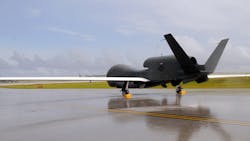High-Resolution AESA Radar Added to Global Hawk Payload
Unmanned aircraft systems (UASs) have supported warfighters for over 15 years, thanks to their intelligence, surveillance, and reconnaissance (ISR) capabilities. They have continuously improved over that time. Northrup Grumman’s next-generation Global Hawk, for example, is capable of flying more than 30 hours at high altitudes. It also carries a Multi-Platform Radar Technology Insertion Program (MP-RTIP) radar, which allows military commanders to receive high-resolution imagery, survey vast geographic regions, and pinpoint targets on the ground in near-real-time.
The MP-RTIP radar relies on active electronically scanned array (AESA) technology, which provides airborne communications and information-sharing capabilities to military units—even in harsh environments. Its high-resolution synthetic aperture radar (SAR) and ground moving target indicator (GMTI) provide high-quality images to commanders when detecting and tracking moving or stationary targets on the ground. That data is then processed by a common image processor (CIP).
The MP-RTIP radar, which was previously only an air-to-ground platform, has added air-to-air capability to support missile defense. With the combination of the radar and the UAS’s ability to fly for long periods at altitudes to 60,000 feet, the new Global Hawk is especially suitable for ISR missions. Combat identification, target tracking, and time-critical targeting are all improved, aiding in the development of predictive battlespace awareness and targeting solutions.
The U.S. Air Force has awarded a $114-million advance procurement contract to Northrop Grumman in preparation of building three more RQ-4 Global Hawks and their associated sensors. The advance is for the three systems’ long-lead items, which include three enhanced sensor suites, three airborne signal-intelligence payloads (ASIP), and two ASIP retrofit kits to be installed on previously purchased aircrafts.
About the Author
Iliza Sokol
Associate Digital Editor
Iliza joined the Penton Media group in 2013 after graduating from the Fashion Institute of Technology with a BS in Advertising and Marketing Communications. Prior to joining the staff, she worked at NYLON Magazine and a ghostwriting firm based in New York.
